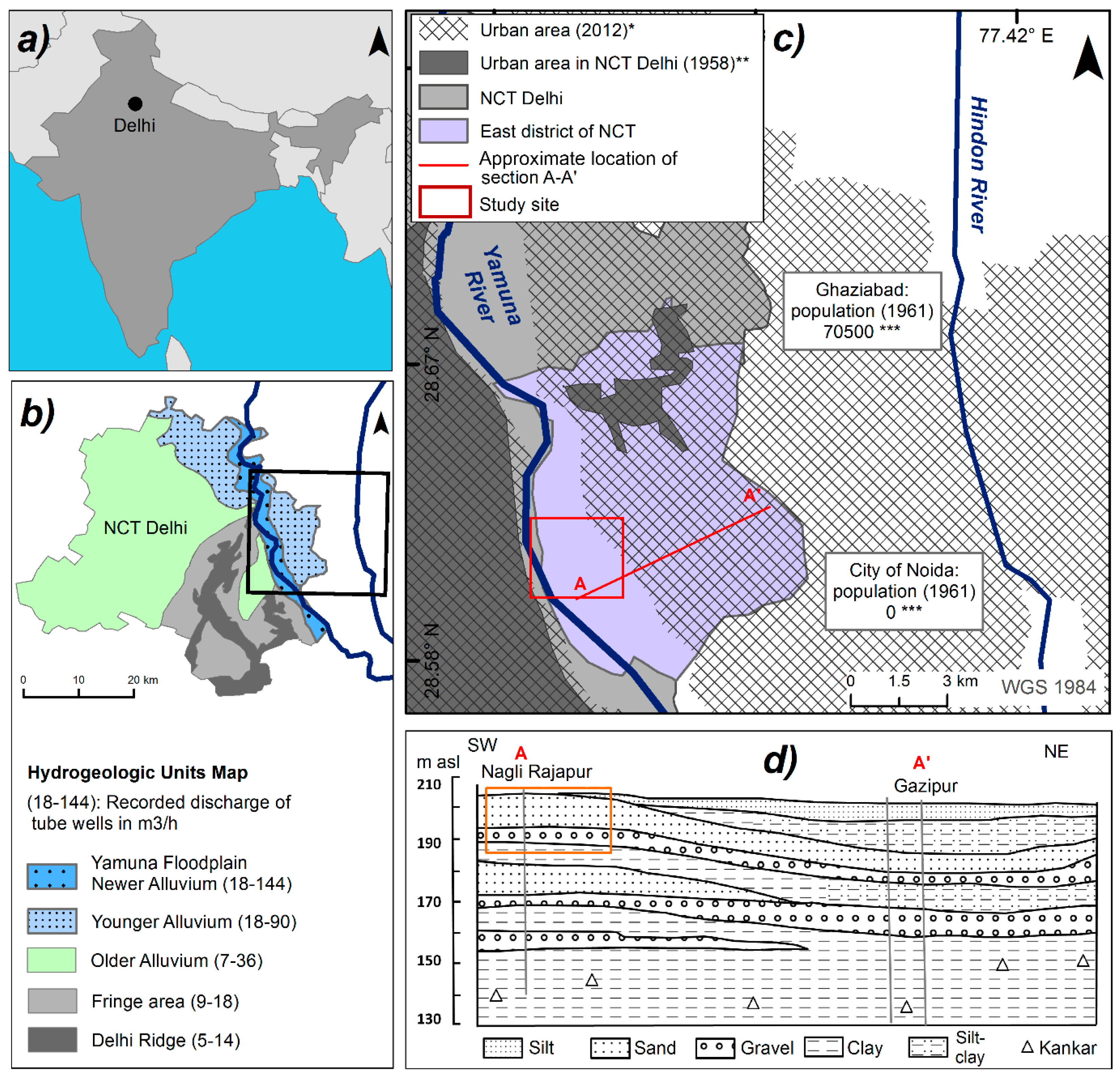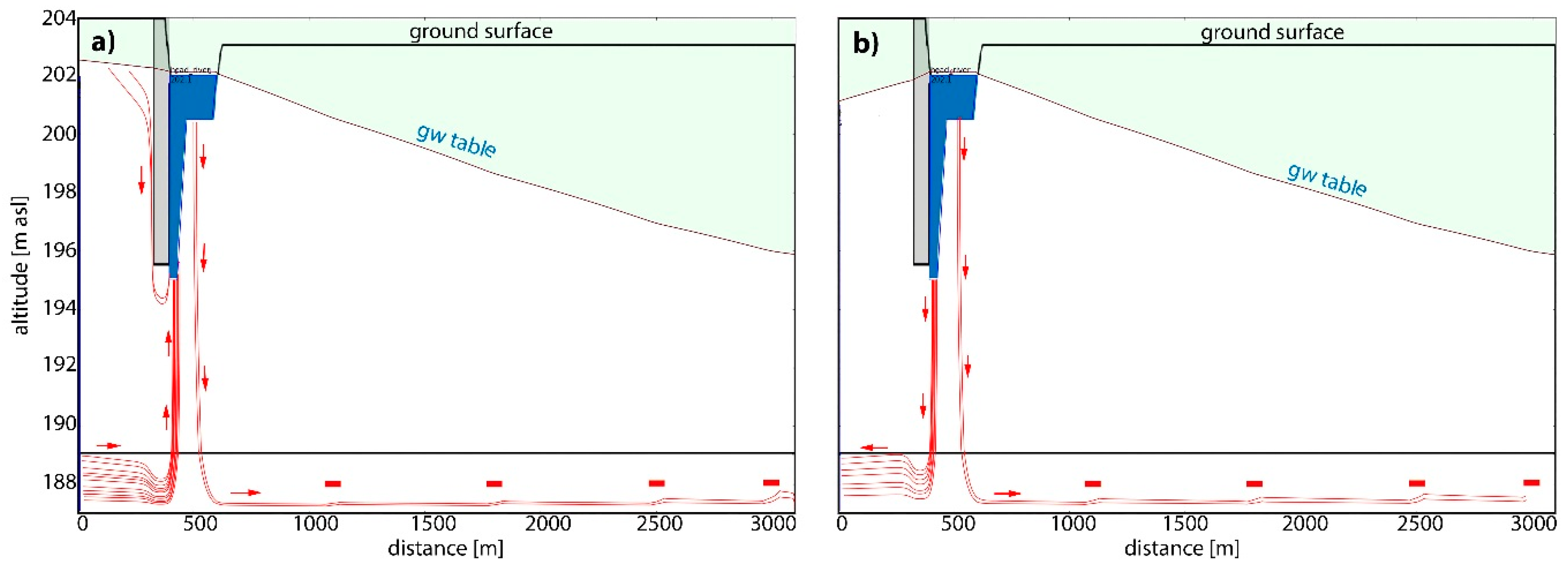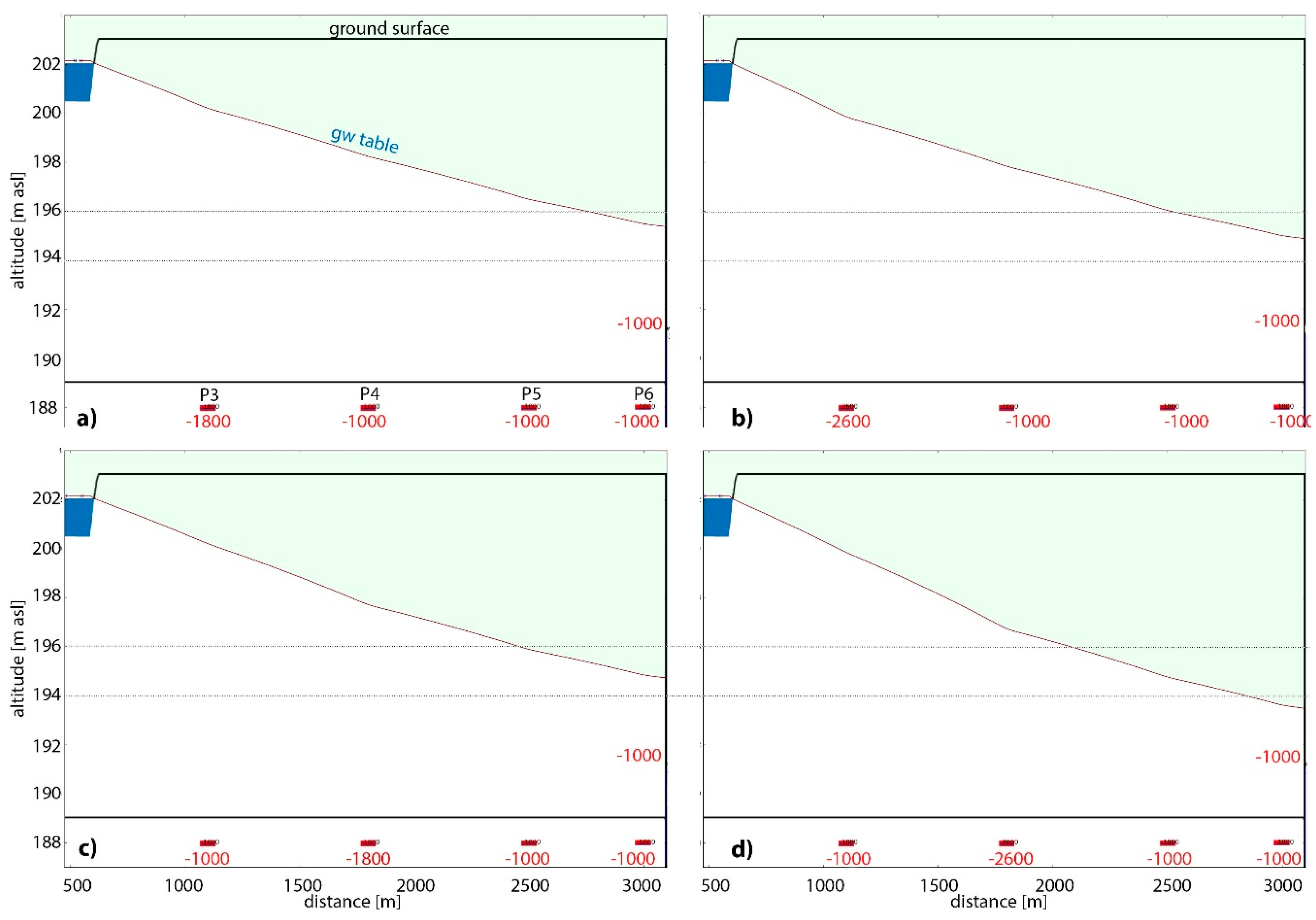Sewage-Borne Ammonium at a River Bank Filtration Site in Central Delhi, India: Simplified Flow and Reactive Transport Modeling to Support Decision-Making about Water Management Strategies
Abstract
:1. Introduction
2. Study Site and Methods
2.1. Study Area and Available Data
2.2. Model Set-Up
2.3. Model Scenarios
2.4. Reactive Transport Modeling
3. Results
3.1. Numerical Models
3.2. Reactive Transport Models
4. Discussion
4.1. Flow Modeling
4.2. Reactive Transport Modeling
4.3. Further Research Needs
4.4. Implications for Groundwater Management
Acknowledgments
Author Contributions
Conflicts of Interest
References
- United Nations. World Urbanization Prospects: The 2014 Revision, Highlights; ST/ESA/SER.A/352; UN: New York, NY, USA, 2014; Available online: http://esa.un.org/unpd/wup/Highlights/WUP2014-Highlights.pdf (accessed on 2 April 2015).
- National Capital Region Planning Board, Ministry of urban Develpoment (India). Draft revised regional plan 2021 National Capital Region; Ministry of Urban Development, Government of India: New Delhi, India, 2013; Available online: http://www.indiaenvironmentportal.org.in/files/file/Draft%20Revised%20Regional%20plan.pdf (accessed on 12 January 2015).
- Massmann, G.; Pekdeger, A.; Heberer, T.; Grützmacher, G.; Dünnbier, U.; Knappe, A.; Meyer, H.; Mechlinski, A. Drinking-Water Production in Urban Environments-Bank Filtration in Berlin. Grundwasser 2007, 12, 232–245. [Google Scholar] [CrossRef]
- Eckert, P.; Irmscher, R. Over 130 years of experience with Riverbank Filtration in Düsseldorf, Germany. J. Water Supply Res. Techno.—Aqua 2006, 55, 283–291. [Google Scholar]
- Orlikowski, D.; Weigelhofer, G.; Hein, T. The impact of river water on groundwater quality in an urban floodplain area, the Lobau in Vienna. In Proceedings of the 36th International Conference of IAD, Austrian Committee Danube Research/IAD, Vienna, Austria, 4—8 September 2006; 4, pp. 200–202. [Google Scholar]
- Dillon, P.J.; Miller, M.; Fallowfield, H.; Hutson, J. The potential of riverbank filtration for drinking water supplies in relation to microsystin removal in brackish aquifers. J. Hydrol. 2002, 266, 209–221. [Google Scholar] [CrossRef]
- Grünheid, S.; Amy, G.; Jekel, M. Removal of bulk dissolved organic carbon (DOC) and trace organic compounds by bank filtration and artificial recharge. Water Res. 2005, 39, 3219–3228. [Google Scholar] [CrossRef] [PubMed]
- Weiss, W.J.; Bouwer, E.J.; Aboytes, R.; LeChevallier, M.W.; O’Melia, C.R.; Le, B.T.; Schwab, K.J. Riverbank filtration for control of microorganisms: Results from field monitoring. Water Res. 2005, 39, 1990–2001. [Google Scholar] [CrossRef] [PubMed]
- Sprenger, C.; Lorenzen, G.; Grunert, A.; Ronghang, M.; Dizer, H.; Selinka, H.C.; Girones, R.; López-Pila, J.M.; Mittal, A.K.; Szewzyk, R. Removal of indigenous coliphages and enteric viruses during riverbank filtration from highly polluted river water in Delhi (India). J. Water Health 2014, 12, 332–342. [Google Scholar] [CrossRef] [PubMed]
- Central Pollution Control Board, Ministry of Environment & Forests, Government of India. Water Quality Status of Yamuna River (1999–2005); ADSORBS/41/2006–07; Central Pollution Control Board: New Delhi, India, 2006; Available online: http://www.cpcb.nic.in/newitems/11.pdf (accessed on 9 September 2014).
- Central Pollution Control Board, Ministry of Environment & Forests, Government of India. Status of Water Quality in India – 2012; MINARS/36 /2013–14; Central Pollution Control Board: New Delhi, India, 2013; Available online: http://www.cpcb.nic.in/WQ_Status_Report2012.pdf (accessed on 5 May 2015).
- Pekdeger, A.; Lorenzen, G.; Sprenger, C. Preliminary report on data of all inorganic substances and physicochemical parameters listed in the Indian and German Drinking Water Standards from surface water and groundwater at the 3 (+1) field sites; TECHNEAU Deliverable D 5.2.2.2008; European Commission: Luxembourg, 2008; Available online: https://www.techneau.org/fileadmin/files/Publications/Publications/Deliverables/D5.2.2.pdf (accessed on 24 Augest 2012).
- Lorenzen, G.; Sprenger, C.; Taute, T.; Pekdeger, A.; Mittal, A.; Massmann, G. Assessment of the potential for bank filtration in a water-stressed megacity (Delhi, India). Environ. Earth Sci. 2010, 61, 1419–1434. [Google Scholar] [CrossRef]
- Groeschke, M.; Kumar, P.; Winkler, A.; Grützmacher, G.; Schneider, M. The role of agricultural activity for ammonium contamination at a riverbank filtration site in central Delhi (India). Environ. Earth Sci. 2016, 75, 1–14. [Google Scholar] [CrossRef]
- Groeschke, M.; Frommen, T.; Taute, T.; Schneider, M. The impact of sewage-contaminated river water on groundwater ammonium and arsenic concentrations at a riverbank filtration site in central Delhi, India. Hydrogeol. J. 2017, 1–13. [Google Scholar] [CrossRef]
- Central Ground Water Board (CGWB), Ministry of Water Resources, Government of India. Groundwater Yearbook 2011–12, National Capital Territory Delhi. Central Ground Water Board; CGWB: New Delhi, India, 2012.
- Central Ground Water Board (CGWB), Ministry of Water Resources, Government of India. Hydrogeological Framework and Ground Water Management Plan of NCT Delhi; CGWB: New Delhi, India, 2006.
- Kumar, M.; Rao, M.S.; Kumar, B.; Ramanathan, A. Identification of aquifer-recharge zones and sources in an urban development area (Delhi, India), by correlating isotopic tracers with hydrological features. Hydrogeol. J. 2011, 19, 463–474. [Google Scholar] [CrossRef]
- Town and Country Planning Organisation, Ministry of Urban Development, Government of India. Evaluation study of DMA towns in National Capital Region (NCR); Government of India: New Delhi, India, 2007. Available online: http://tcpomud.gov.in/divisions/mutp/dma/final_dma_report.pdf (accessed on 2 April 2015).
- Central Ground Water Board (CGWB), Ministry of Water Resources, Government of India. Ground Water Information Booklet of East District, NCT, Delhi; CGWB: New Delhi, India, 2013. Available online: http://cgwb.gov.in/District_Profile/Delhi/East.pdf (accessed on 21 September 2015).
- Das, B.K.; Kakar, Y.P.; Moser, H.; Stichler, W. Deuterium and oxygen-18 studies in groundwater of the Delhi area, India. J. Hydrol. 1988, 98, 133–146. [Google Scholar] [CrossRef]
- Chatterjee, R.; Gupta, B.; Mohiddin, S.; Singh, P.; Shekhar, S.; Purohit, R. Dynamic groundwater resources of National Capital Territory, Delhi: assessment, development and management options. Environ. Earth Sci. 2009, 59, 669–686. [Google Scholar] [CrossRef]
- Central Ground Water Board (CGWB), Ministry of Water Resources, Government of India. Ground Water Yearbook 2005–2006. National Capital Territory Delhi; CGWB: New Delhi, India, 2006.
- Sprenger, C. Technical report—Numerical modelling of surface-/groundwater interactions at the flood plain in Delhi (India). SAPH PANI Project report. 2013; (unpublished). [Google Scholar]
- Sinha, R.; Jain, V.; Babu, G.P.; Ghosh, S. Geomorphic characterization and diversity of the fluvial systems of the Gangetic Plains. Geomorphology 2005, 70, 207–225. [Google Scholar] [CrossRef]
- Kazim, M.K.; Kumar, R.; Kumar, H.; Gupta, A.K.; Bagchi, J.; Srivastava, S.S. Geological and geomorphological mapping of NCT Delhi on 1:10,000 scale; Field Season 2005–06, 2006–07 and 2007–08; Geological Survey of India: New Delhi, India, 2008. [Google Scholar]
- Harbaugh, A.W.; Banta, E.R.; Hill, M.C.; McDonald, M.G. MODFLOW-2000, the U.S. Geological Survey Modular Ground-Water Model - User Guide to Modularization Concepts and the Ground-Water Flow Process; Open-File Report 00–92; USGS: Reston, VA, USA, 2000. Available online: http://pubs.er.usgs.gov/publication/ofr200092 (accessed on 16 May 2014).
- Atteia, O. iPht3d Manual Version 2-e 28/05/2014. 2014, p. 23. Available online: http://oatteia.usr.ensegid.fr/iPht3d/ (accessed on 4 July 2014).
- Beyer, W. Zur Bestimmung der Wasserdurchlässigkeit von Kiesen und Sanden aus der Kornverteilungskurve. Wasserwirtschaft Wassertechnik 1964, 14, 165–168. [Google Scholar]
- Kinzelbach, W.; Rausch, R. Grundwassermodellierung: eine Einführung mit Übungen; Gebrüder Borntraeger: Stuttgart, Berlin, Germany, 1995; pp. 158–161. [Google Scholar]
- Holtschlag, D.J.; Luukkonen, C.L.; Nichols, J.R. Simulation of Ground-Water Flow in the Saginaw Aquifer, Clinton, Eaton, and Ingham Counties, Michigan; USGS: Reston, VA, USA, 1996. Available online: http://pubs.usgs.gov/wsp/2480/report.pdf (accessed on 19 September 2015).
- Parkhurst, D.L.; Appelo, C.A.J. Description of Input and Examples for PHREEQC Version 3 - A Computer Program for Speciation, Batch-Reaction, One-Dimensional Transport, and Inverse Geochemical Calculations; USGS: Reston, VA, USA, 2013. Available online: http://pubs.usgs.gov/tm/06/a43/ (accessed on 9 September 2014).
- Sprenger, C. Surface-/groundwater interactions associated with river bank filtration in Delhi (India)—Investigation and modelling of hydraulic and hydrochemical processes. Ph.D. Thesis, Freie Universität Berlin, Berlin, Germany, 2011. [Google Scholar]
- Groeschke, M. Transport and Fate of Ammonium at a Riverbank Filtration Site in Delhi (India): Assessment of the Groundwater Contamination, Treatment Strategies and Recommendations for an Adapted Management. Ph.D. Thesis, Freie Universität Berlin, Berlin, Germany, 2016. [Google Scholar]
- Gelhar, L.W.; Welty, C.; Rehfeldt, K.R. A critical review of data on field-scale dispersion in aquifers. Water Resour. Res. 1992, 28, 1955–1974. [Google Scholar] [CrossRef]
- Eybing, M. Charakterisierung eines alluvialen Grundwasserleiters in Delhi (Indien): Sedimentanalysen von Bohrungen an einem Uferfiltrationsstandort am Yamuna. (Characterization of an alluvial aquifer in Delhi, India: Sediment analyses of samples from drillings at a riverbank filtration site at the Yamuna River). B.Sc. Thesis, Freie Universität Berlin, Insitute of Geological Sciences, Berlin, Germany, 2014. [Google Scholar]
- Groeschke, M.; Frommen, T.; Grützmacher, G.; Schneider, M.; Sehgal, D. Application of Bank Filtration in Aquifers Affected by Ammonium–The Delhi Example. In Natural Water Treatment Systems for Safe and Sustainable Water Supply in the Indian Context: Saph Pani; Wintgens, T., Anders, N., Elango, L., Asolekar, R.S., Eds.; IWA Publishing: London, UK, 2015; pp. 57–77. [Google Scholar]
- Shekhar, S.; Prasad, R.K. The groundwater in the Yamuna flood plain of Delhi (India) and the management options. Hydrogeol. J. 2009, 17, 1557–1560. [Google Scholar] [CrossRef]
- Rangarajan, R.; Athavale, R.N. Annual replenishable ground water potential of India—an estimate based on injected tritium studies. J. Hydrol. 2000, 234, 38–53. [Google Scholar] [CrossRef]
- Su, G.W.; Jasperse, J.; Seymour, D.; Constantz, J. Estimation of Hydraulic Conductivity in an Alluvial System Using Temperatures. Ground Water 2004, 42, 890–901. [Google Scholar] [CrossRef] [PubMed]
- Sprenger, C.; Lorenzen, G. Hydrogeochemistry of Urban Floodplain Aquifer Under the Influence of Contaminated River Seepage in Delhi (India). Aquat Geochem. 2014, 20, 519–543. [Google Scholar] [CrossRef]
- Rittmann, B.E. Analyzing Biofilm Processes Used in Biological Filtration. J. Am. Water Works Assoc. 1990, 82, 62–66. [Google Scholar] [CrossRef]
- Li, M.; Zhu, X.; Zhu, F.; Ren, G.; Cao, G.; Song, L. Application of modified zeolite for ammonium removal from drinking water. Desalination 2011, 271, 295–300. [Google Scholar] [CrossRef]
- Gauntlett, R.B. Removal of Nitrogen Compounds. In Developments in Water Treatment 2; Lewis, W.M., Ed.; Applied Science Publishers: London, UK, 1980; pp. 53–78. [Google Scholar]
- Takó, S.; Laky, D. Laboratory Experiments for Arsenic and Ammonium Removal—The Combination of Breakpoint Chlorination and Iron(III)-Coagulation. J. Environ. Sci. Eng. 2012, 1165–1172. [Google Scholar]





| Parameter | Value (General) | Values in Different Zones | |||
|---|---|---|---|---|---|
| Sand | Kankar | Silt-Clay | River | ||
| Flow simulation | Steady state | --- | --- | --- | --- |
| Aquifer type | Free | --- | --- | --- | --- |
| Simulation time (days) | 1000 | --- | --- | --- | --- |
| Model extent column, x-direction (m) | 3100 | --- | --- | --- | --- |
| Model extent layer, z-direction (m) | 17 | --- | --- | --- | --- |
| Zmin (m a.s.l.) | 187 | --- | --- | --- | --- |
| Zmax (m a.s.l.) | 204 | --- | --- | --- | --- |
| Model thickness (y-direction) (m) | 2600 | --- | --- | --- | --- |
| Grid spacing Δx (m) | 4 (2) | --- | --- | --- | --- |
| Grid spacing Δz (m) | 0.2 | --- | --- | --- | --- |
| Horizontal hydraulic conductivity (m/d) | --- | 25 | 83 | 0.86 | 86,400 |
| Vertical hydraulic conductivity (m/d) | --- | 3.6 | 12 | 0.43 | 86,400 |
| Recharge (m/d) | 0.0002 | --- | --- | --- | --- |
| Parameter | Value |
|---|---|
| Model extent column, x-direction (m) | 2625 |
| xmin (m) | 475 |
| xmax (m) | 3100 |
| Number of columns | 525 |
| Parameter | Unit | Sand | Kankar |
|---|---|---|---|
| Effective Porosity (ne) * | --- | 0.24 | 0.175 |
| Number of exchange sites | meq/1 L water | 0.054 | 0.21 |
| log_kNa\K | --- | 0.98 | 0.67 |
| log_kNa\Ca | --- | 0.18 | 0.10 |
| log_kNa\Mg | --- | −0.09 | −0.28 |
| log_kNa\NH4 | --- | 0.81 | 0.55 |
| Para-Meter | Unit | Adsorption Experiments | Desorption Experiments | ||||
|---|---|---|---|---|---|---|---|
| Equil. Solution Sand | Equil. Solution Kankar | Displacing Solution | Equil. Solution Sand | Equil. Solution Kankar | Displacing Solution | ||
| T | °C | 25.0 | 25.0 | 25.0 | 25.0 | 25.0 | 25.0 |
| pH | pH | 7.58 | 7.4 | 7.6 | 6.93 | 7.23 | 8.56 |
| Eh | mV | 160 | 175 | 82 | 105 | 84 | 268 |
| EC | µS/cm | 495 | 893 | 1588 | 1615 | 1153 | 457 |
| Na | mg/L | 19.9 | 67.5 | 171 | 97 | 79.7 | 35 |
| K | mg/L | 5.4 | 6.8 | 15.4 | 17.3 | 13.2 | 9 |
| Mg | mg/L | 14 | 23 | 33.7 | 38.7 | 24.8 | 14 |
| Ca | mg/L | 63.7 | 80 | 65.4 | 126.5 | 89.1 | 44 |
| Fe | mg/L | 0.09 | 0.1 | 0.07 | 16.9 | 5.2 | 0.62 |
| Mn | mg/L | 0.09 | 0.3 | 0.3 | 0.42 | 0.27 | 0.05 |
| HCO3− | mmol/L | 5.2 | 5.9 | 6.5 | 11.9 | 8.3 | 2.7 |
| Cl | mg/L | 6 | 78 | 218 | 141 | 115 | 38 |
| SO4 | mg/L | 2 | 53 | 125 | 5 | 4 | 46 |
| S2− | mg/L | 0 | 0 | 0 | 0.04 | 0 | 0 |
| NH4+ | mg/L | 0 | 0.6 | 20 | 35 | 26 | 0.1 |
| NO2− | mg/L | 0.005 | 0.03 | 0.02 | 0.005 | 0.005 | -- |
| NO3− | mg/L | 0 | 3.5 | 0 | 0 | 0.05 | -- |
| Model | Pumping Rate (m3/d/well) | Inflow (Heads) (m3/d) | Recharge (m3/d) | Well (out) (m3/d) | Flux (out) (m3/d) | HeadEast (m a.s.l.) |
|---|---|---|---|---|---|---|
| Model 3 | 1000 | 3699 | 1305 | 4005 | 1000 | 195.8 |
| Model 3 | 1200 | 4493 | 1305 | 4799 | 1000 | 194.4 |
| Model 3 | 1400 | 5299 | 1305 | 5604 | 1000 | 192.8 |
| Model 4 | 1000 | 3627 | 1305 | 4005 | 927 | 196 |
| Model 4 | 1200 | 3940 | 1305 | 4799 | 448 | 196 |
| Model 4 | 1400 | 4298 | 1305 | 5604 | 0 | 196 |
| Model 3 | P3: 1800 * | 4499 | 1305 | 4805 | 1000 | 195.3 |
| Model 3 | P4: 1800 * | 4499 | 1305 | 4805 | 1000 | 194.7 |
| Model 3 | P3: 2600 * | 5299 | 1305 | 5605 | 1000 | 194.8 |
| Model 3 | P4: 2600 * | 5299 | 1305 | 5605 | 1000 | 193.4 |
© 2017 by the authors. Licensee MDPI, Basel, Switzerland. This article is an open access article distributed under the terms and conditions of the Creative Commons Attribution (CC BY) license (http://creativecommons.org/licenses/by/4.0/).
Share and Cite
Groeschke, M.; Frommen, T.; Winkler, A.; Schneider, M. Sewage-Borne Ammonium at a River Bank Filtration Site in Central Delhi, India: Simplified Flow and Reactive Transport Modeling to Support Decision-Making about Water Management Strategies. Geosciences 2017, 7, 48. https://doi.org/10.3390/geosciences7030048
Groeschke M, Frommen T, Winkler A, Schneider M. Sewage-Borne Ammonium at a River Bank Filtration Site in Central Delhi, India: Simplified Flow and Reactive Transport Modeling to Support Decision-Making about Water Management Strategies. Geosciences. 2017; 7(3):48. https://doi.org/10.3390/geosciences7030048
Chicago/Turabian StyleGroeschke, Maike, Theresa Frommen, Andreas Winkler, and Michael Schneider. 2017. "Sewage-Borne Ammonium at a River Bank Filtration Site in Central Delhi, India: Simplified Flow and Reactive Transport Modeling to Support Decision-Making about Water Management Strategies" Geosciences 7, no. 3: 48. https://doi.org/10.3390/geosciences7030048





